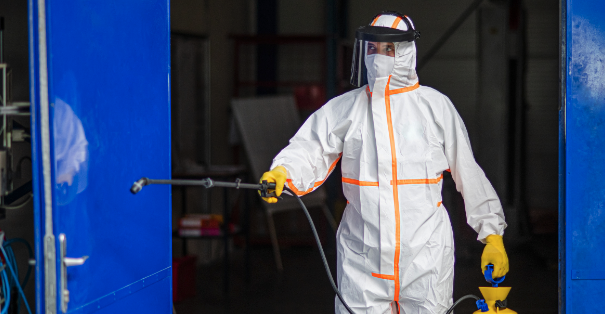SafeDE News
Smarter workplaces are safer workplaces. SafeDE is your resource for OSHA news, regulation changes, recalls, and everything to keep your business safe.
Preventing Ergonomic Injuries: Tips and Strategies
Ergonomic injuries are prevalent in jobs that involve long periods of sitting, repetitive tasks, and the use of poorly designed equipment. A workplace environment that inadvertently encourages bad posture, fatigue, and awkward movements may lead to both acute and chronic ergonomic injuries over time. Carpal tunnel syndrome, neck pain, and back pain are some common examples of musculoskeletal disorders (MSDs) caused by ergonomic hazards.
In 2018, the U.S. Bureau of Labor Statistics reported that over 30% of all occupational injuries are ergonomic. In order to address this problem, the Occupational Safety and Health Administration (OSHA) enforced the General Duty Clause, Section 5(a)(1) requiring all employers to keep their workplaces free from any ergonomic hazards that may cause MSDs. A properly planned workplace can greatly reduce the risk of ergonomic injuries and improve productivity.
How to Prevent Ergonomic Injuries in the Workplace
Ergonomics is the applied science of designing and arranging a work environment so people can interact with objects as efficiently and safely as possible.
Here are some important tips on how to prevent ergonomic injuries in the workplace:
- Choose a Comfortable Chair. The ideal chair for any workstation should be adjustable to your height and comfortable enough to support your back for an extended period. There are many other types of ergonomic chairs available, so choose one that best suits your work environment.
- Swivel chairs provide flexibility in movement, allowing you to easily turn and reach different areas without straining your body.
- Balance chairs feature a rounded or swiveling base, promoting subtle movements and shifts in weight to encourage you to actively engage your core muscles while seated. This constant engagement of core muscles helps improve posture, strengthen abdominal and back muscles, and reduce the risk of discomfort or strain associated with prolonged sitting.
- Kneeling chairs promote a more open hip angle, which can reduce lower back strain and improve spinal alignment. By distributing the user's weight between the seat and knee pads, the design encourages an upright posture, reducing the pressure on the lumbar spine and promoting a more natural curvature in the spine.
- Mesh chairs are a great choice if you want a comfortable seat that allows airflow on your back, especially in hot temperatures.
- Use an Ergonomic Keyboard and Mouse. An ergonomic mouse offers a more relaxed grip since it fits the natural shape of your hand. It may also come with extra features like a thumb rest and customizable buttons. On the other hand, ergonomic keyboards have a split or curved design that lets your hands rest in a natural position. Try to maintain a straight wrist position when typing or using the mouse to reduce the risk of chronic joint or nerve injuries.
- Adjust Monitor Distance. Position your computer monitor within arm’s length to reduce eye strain. Maintain the top of the screen at or slightly below eye level to avoid slouching and straining your neck. Use a monitor stand or laptop stand if necessary to set up your screen at the optimal viewing distance.
- Rearrange Your Desk. Set up your work desk in a way that reduces strain on your neck, arms, and back. Your mouse and keyboard must be aligned at the same level and within reach. You may also use wrist cushions to keep your hands comfortable when you type. Having a document holder near the computer to minimize the need to constantly look down to read while typing can be beneficial.
- Allow Enough Lighting. Ensure your workspace is well-lit to minimize visual discomfort that may lead to eye strain, headache, and fatigue. Task lighting refers to the use of localized illumination for a particular area in your workspace to help your eyes focus on specific tasks. Reduce the brightness of your computer screen especially if you do not wear eyeglasses with anti-glare coating. Using light devices with a color temperature that simulates natural daylight also helps reduce eye strain.
- Use a Headset. If your work involves frequent phone calls, consider using a hands-free headset to avoid holding the phone between your ear and shoulder, which can lead to neck and shoulder strain.
- Cable Organization. Keep cables and cords neatly organized and maintain an uncluttered workspace to decrease tripping hazards.
- Alternate Between Sitting and Standing. Keep your legs moving to promote blood circulation throughout your body. Consider using a sit-stand desk that allows you to alternate between sitting and standing positions throughout the day.
- Ergonomic Training. Ask your employer if they have access to programs that help improve ergonomics at work. Most of these resources are free so it is best to learn as many strategies as you can to reduce the risk of injuries on the job.
Preventing ergonomic injuries at work is crucial for maintaining your long-term health and well-being. By implementing these tips and strategies, you can create a workspace that minimizes physical strain, reduces the risk of injuries, and promotes overall comfort and productivity. Ergonomics is not a one-size-fits-all solution, so it's essential to tailor your workspace to your specific needs and make adjustments as necessary. Prioritizing ergonomics today can lead to a healthier and more comfortable work life in the long run.
Frequently Asked Questions (FAQs)
What are ergonomic injuries and why do they matter?
Ergonomic injuries are prevalent in poorly designed workplaces that lead to increased strain on the muscles and joints. It is important to address the factors that cause these injuries to prevent chronic pain and long-term health issues among employees.
What are some common causes of ergonomic injuries?
Ergonomic injuries are commonly caused by workplace environments that promote poor posture, repetitive motions, fatigue, and awkward or improper use of equipment.
How can ergonomic injuries be prevented in the workplace?
Ergonomic injuries in the workplace can be prevented primarily by setting up a workstation that does not cause excessive strain on your back, neck, and limbs. Invest in chairs with lumbar support, and ergonomic computer accessories to reduce strain on your body.
What is the OSHA ergonomic standard and how does it apply?
OSHA’s General Duty Clause, Section 5(a)(1) states that employers must enforce hazard prevention protocols to minimize serious accidents. During workplace inspections, OSHA issues citations or hazard alert letters wherever applicable. Follow-up investigations are then conducted within 12 months to confirm if the hazards have been addressed.
What are some examples of ergonomic injury prevention strategies?
You can reduce the risk of ergonomic injuries at work by using ergonomic chairs, lighting, and computer accessories. These objects should be positioned in a way that supports your body to minimize eye and muscle fatigue, especially when you are staying in one position for a long time.
How do ergonomic injuries affect employee productivity and morale?
Poor ergonomics can lead to reduced productivity as workers may struggle to complete their tasks on time due to MSDs. The lack of preventative strategies for ergonomic injuries may also lower overall morale due to higher stress levels, and increase business expenses due to employee absences.
Which parts of the body are most commonly affected by poor ergonomics?
The neck and shoulders are usually strained due to incorrect monitor height or suboptimal positioning of your desk or chair. Back pain is commonly caused by a lack of lumbar support or prolonged sitting in a bad posture. Hand and wrist injuries are a result of improper keyboard and mouse setups or incorrect use of these tools.
Get SafeDE News
Workplace safety for all businesses.
SafeDE provides FREE comprehensive onsite surveys for small and medium sized private sector establishments to identify potential workplace hazards, improve safety and health management systems, and assist in voluntary compliance with federal OSHA regulations.
Related News
-1.png)
Crane Hand Signals: Guide to OSHA-Compliant Safety
-1.png)
Tips for Selecting the Right Hard Hat for Electrical Work
-1.png)
Essential Tips to Prevent Heat Illness in the Workplace

Essential PPE for Staying Safe and Comfortable in Hot Work Environments
-1.png)
Recognizing Warning Signs of Heat Illness at Work
.png)
How Forklift Stability & Center of Gravity Connected?

Mastering First Aid: Steps for Effective Injury Assessment
.png)


.png)

